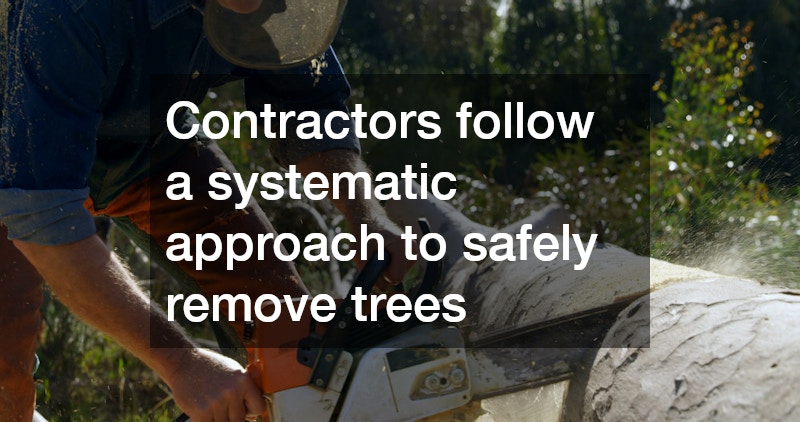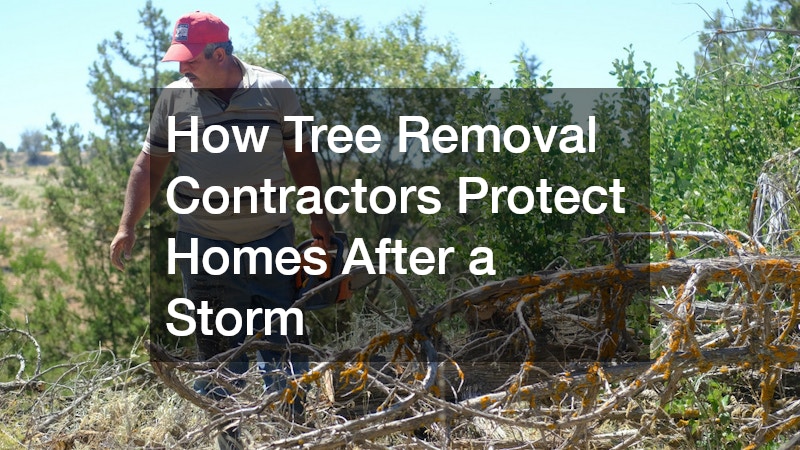In the aftermath of a storm, fallen trees and debris can pose significant threats to homes and properties. Tree removal contractors play a crucial role in ensuring safety and restoring order. With their expertise and specialized equipment, they can effectively mitigate the risks associated with storm damage.
This article delves into the various aspects of tree removal and how it safeguards homes and communities.
Dangers of Fallen Trees
Fallen trees can cause physical damage to homes, power lines, and vehicles. The weight of a large tree can easily crush a roof or damage siding, leading to expensive repairs. Additionally, downed power lines can pose severe electrical hazards, further complicating the recovery process. Homeowners need to understand these risks to prioritize safety and address issues as soon as they arise.
Moreover, the aftermath of a storm is often chaotic, with debris scattered everywhere. This chaos can hinder rescue and recovery efforts, making it vital to clear the area of hazardous materials quickly. Fallen trees can also obstruct roads, making it difficult for emergency services to access impacted areas. By recognizing the dangers, homeowners can act rapidly to protect their families and property.
Furthermore, the presence of damaged trees in a yard can pose long-term risks. Trees that have cracked limbs or are leaning precariously may eventually fall, resulting in additional damage and injury. Identifying and dealing with these risks promptly is essential for maintaining a safe living environment after a storm.
Professional Damage Assessment
Experienced tree removal contractors use specific techniques and equipment to evaluate the condition of trees and surrounding structures before deciding on the best course of action. They begin with a visual inspection to identify trees that may be unstable or dangerous. This initial assessment helps prioritize which trees need immediate attention and which may be safely left alone.
Employing tools such as binoculars and specialized diagnostic equipment, contractors can assess the health of trees from a distance. This helps to determine whether a tree is structurally sound or if it poses an imminent threat to nearby properties. The use of technology allows for a thorough evaluation while minimizing risks to the assessors.
After the initial assessment, tree removal contractors consider environmental factors as well. Soil saturation, wind direction, and the tree’s proximity to other structures all influence the decision-making process. By taking these factors into account, professionals can create a detailed plan of action that minimizes risk during the removal process.
Safe Removal Approaches
Contractors follow a systematic approach to safely remove trees, ensuring minimal risk to the property and themselves while adhering to safety protocols. The removal process typically begins with the establishment of a safety perimeter around the area. This prevents unauthorized individuals from entering the danger zone and allows the contractors to work without interruptions.
Next, tree removal contractors prepare the site by clearing away any smaller debris and obstacles that could hinder the removal process. They use specialized equipment such as chainsaws, rigging systems, and chippers to handle different aspects of the removal. This equipment allows for a controlled and efficient removal, protecting both the surrounding environment and the workers involved.
Finally, proper disposal of the tree debris is an important step. Contractors often have connections with local recycling or waste management services that facilitate responsible disposal. Some companies even offer wood chipping services, turning tree limbs into mulch that can be reused in landscaping. This focus on safety and environmental impact helps ensure a thorough and responsible tree removal process.
Future Damage Prevention
Addressing hazardous trees or branches can significantly reduce the likelihood of future incidents, making preventive measures essential for homeowners. Regular evaluations of trees after storms help identify those that may pose risks in the future. By proactively removing problem trees, homeowners can prevent potential damage from falling branches or root instability.
Proper tree maintenance, including trimming and pruning, along with removal, contributes to the overall health of the landscape. Healthy trees are less likely to become hazards during storms and can withstand high winds and heavy rains more effectively. This proactive approach not only enhances safety but also promotes the longevity and aesthetic value of the property.
Investing in regular tree assessment and maintenance is a long-term strategy that pays off in reduced risks and lower repair costs. Ultimately, a clean and well-maintained yard helps maximize property value while ensuring safety for homeowners and their neighbors alike. It’s clear that effective tree removal is a key component of storm preparedness and recovery.
Traits of Skilled Contractors
Homeowners should look for credentials, experience, insurance, and customer reviews to ensure they choose a reliable and skilled contractor for their tree removal needs. Verifying licenses and certifications demonstrates a contractor’s commitment to professionalism and adherence to safety standards. This information also assures homeowners that the contractor is qualified to handle the complexities of tree removal, especially in post-storm conditions.
Insurance coverage is another critical consideration when hiring a tree removal contractor. Adequate insurance protects homeowners from potential liabilities in the event of accidents or damages that occur during the removal process. A reputable contractor should provide proof of insurance and be willing to answer any questions the homeowner may have about their policy.
Finally, researching customer reviews can offer valuable insights. Online reviews and testimonials reflect past customer experiences, helping homeowners gauge a contractor’s reliability, workmanship, and customer service. It is beneficial to gather multiple viewpoints before making a decision, ensuring that homeowners choose a contractor who is consistent in delivering quality service.
Tree removal contractors play an essential role in safeguarding properties and ensuring safety after storms. By understanding the process and knowing how to select the right professionals, homeowners can better protect their homes. It’s important to recognize the value of these services not only in immediate crisis management but in promoting long-term tree health and safety as well. Investing in qualified contractors can make the difference between a safe recovery and further complications.


